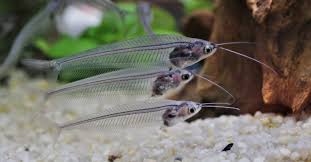Top Fin Aquatics
Glass Catfish
Glass Catfish
Pickup available at 42 Coley Street
Usually ready in 24 hours
Glass Catfish Care Guide
Glass Catfish (Kryptopterus vitreolus) are peaceful, transparent fish that bring a fascinating and delicate beauty to community aquariums. Their unique appearance and shoaling behavior make them a standout choice for well-maintained tanks.
Overview
- Scientific Name: Kryptopterus vitreolus
- Common Name: Glass Catfish (also sold as Ghost Catfish)
- Synonyms: None
- Distribution: Western Borneo, Indonesia
- Maximum Size: 7 cm (2.76")
- Temperature Range: 24–28°C (75–82°F)
- Water Parameters: pH 6.0–8.0, dH up to 20; adaptable to a wide range of conditions.
- Lighting: Low, with diffused light preferred.
- Compatibility: Peaceful community species.
- Sexual Dimorphism: Unknown.
Description & Habitat
Glass Catfish are an unusual and stunning species with a completely transparent body, making their internal organs and muscle structure visible. This oddball species thrives in groups of 6 or more and requires a well-planted aquarium to replicate its natural habitat:
- Natural Habitat: Slow-moving waters with dense vegetation in Western Borneo.
- Tank Setup: Provide both gentle and moderate water currents, as well as floating plants to diffuse light and create shaded areas.
- Social Behavior: Highly social and shy, Glass Catfish are best kept in shoals to reduce stress and encourage natural behavior.
Feeding
Glass Catfish can be finicky eaters but thrive on a diet rich in frozen and live foods:
- Staples: Small frozen foods such as mosquito larvae, daphnia, cyclops, and brine shrimp.
- Notes: They may be reluctant to eat dried foods. Avoid purchasing these fish if you cannot provide a steady supply of frozen or live food.
Breeding
Breeding Glass Catfish in home aquariums is rare, and detailed reports are not widely available:
- Reproductive Method: Egg scatterers.
- Conditions: It is believed they require soft water for spawning.


